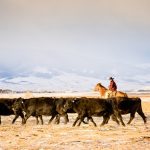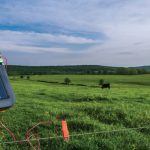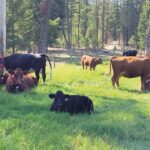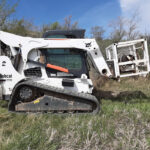
Tag Archives fencing

How barbed wire transformed ranching in the West
Vet Advice with Dr. Ron Clarke
Ranching in southern Alberta can be divided into two eras. One before the fence, and the one that came to stay, after the fences. From D. Larraine Andrews’s book, Ranching Under the Arch:“Responding to the new lease legislation, four corporate ranches, dubbed the Patriarchs, arrive under open range practices dependent on chinooks to keep grasslands […] Read more

Vence virtual fence pilot starts in Saskatchewan
"We're going to just do whatever the tech is going to allow us to do."
Golden light shines through the window into Mosaic Stadium’s Harvard Lounge and onto the stage, but as John and Deanne Chuiko take the stage, the light settles on the horizon and a winter prairie night spreads through the sky. Outside, people bustle in and out of the REAL District as Agribition rages. John and Deanne […] Read more

Virtual fencing pilot coming to Saskatchewan
Project to explore whether new technology is feasible for Canadian producers
Given how time-consuming and expensive fencing can be, it’s little wonder that virtual fencing has piqued the interest of farmers and ranchers in Canada and beyond. But is the juice worth the squeeze? One cattle group in Saskatchewan aims to find out. Chad MacPherson, the general manager of the Saskatchewan Stock Growers Association (SSGA), says […] Read more

Electric fencing tips for fall and winter grazing
Industry reps share the ins and outs of using electric fence effectively and safely
Every year, winter grazing becomes more common as it is often considered more sustainable and can cut feed costs. In addition, producers may graze farmland after harvest for the same reason. However, these things can be tough to manage without electric fence, and when it comes to electric fence, producers need to know how to […] Read more

Florida farmers scramble to reach cattle after Hurricane Ian
Chicago | Reuters — Farmers in Florida rushed to reach their cattle on Thursday after trees downed by Hurricane Ian broke fences used to contain the animals and rain from the fierce storm flooded fields used for grazing. One of the mightiest storms to hit the U.S. mainland in recent years, Ian flooded communities on […] Read more

Saskatchewan shores up disaster program for bigger farms
Program extends PDAP aid to higher-revenue farm businesses
Saskatchewan farmers whose operations took damage from storms in April, but whose gross revenues overtopped the maximum for disaster assistance, will now be able to get in on that program. The province on June 16 announced “supplemental relief” via the Provincial Disaster Assistance Program to help farmers who didn’t qualify under PDAP’s usual eligibility rules. […] Read more

Time-saving tips for electric fences
Whether you’re setting up or troubleshooting an electric fence, these tips can make your life easier
Rotational grazing generally makes better use of pastures than season-long grazing, allowing plants time to recover and produce more forage. Temporary electric fencing makes rotation quick and easy, but it’s not without its problems. Steve Kenyon, a rancher near Busby, Alta., has been rotational grazing for a long time and bale grazing for more than […] Read more

Saskatchewan clarifying certain on-farm PST exemptions
More items to be specified as exempt in tax regulations
Saskatchewan farmers’ and ranchers’ concerns about some inconsistencies in how and when provincial sales tax is applied to purchases of on-farm equipment will be dealt with in a revised list effective late next week. The province said Wednesday in a budget release that a “number of clarifications” will be made to its Provincial Sales Tax […] Read more

Testing virtual fencing’s potential in B.C.
Pilot underway to develop technology fitting the needs of grazing in B.C.
When the British Columbia Cattlemen’s Association initiated a targeted grazing project to reduce wildfire risk in the wildland-urban interface, the prospect of rebuilding lost fencing to facilitate this was costly. An estimated 900 kilometres of fenceline in B.C was burned in wildfires during 2017 and 2018, with a staggering projected rebuild cost of $14 million. […] Read more

Removing old wire fences
Custom fencers share their tips for cleaning up old fencelines more efficiently and with less risk of injury
When an old wire fence has deteriorated and needs to be replaced, removing the old posts and wires can be time-consuming. Then there’s the task of hauling them off and disposing of them. Custom fencers have the goods on removing those fences with less hassle, whether you’ve got a wire-winder or are rolling by hand. […] Read more



